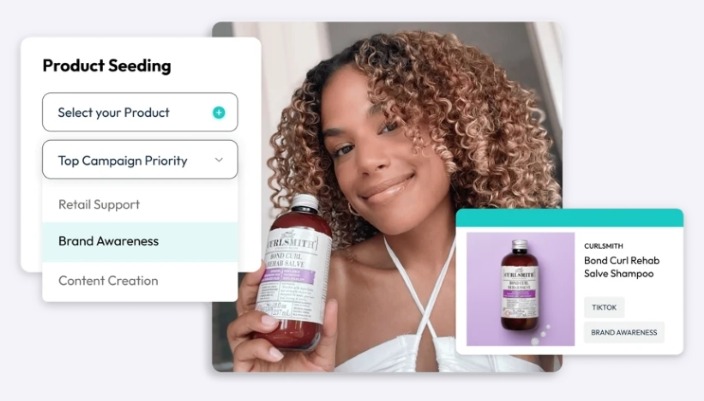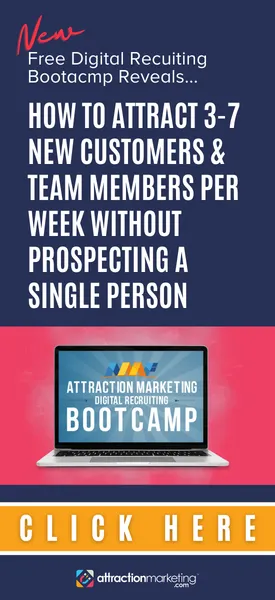Product seeding refers to sending products to creators for them to promote on social media.
And seeding is seeing a big resurgence among CPG brands collaborating with creators.
Because seeding influencers is a proven path to word-of-mouth and UGC with no handholding.
Given the legwork of shipping hundreds of products, seeding campaigns can be complicated. The process can feel like a time-sink and measuring results can be murky, especially when done at scale.
But with the right strategy and tools, brands can confidently do high-volume product seeding to…
- Build meaningful awareness for product launches
- Earn 100s of pieces of user-generated content (to promote organically or via paid ads)
- Increase share of voice and word-of-mouth (and social SEO)
Given that our micro-influencer platform has powered 10,000s of product fulfillments, we know all about seeding firsthand. Below we’ll break down everything you need to know about the process.
What is Product Seeding?
Product seeding means sending products to creators to earn word-of-mouth on social media. In most cases, these products are packaged in a seeding kit (AKA “influencer box”). Creators that you seed are typically prior customers or past collaborators with your brand (or both).
Despite involving many moving pieces, the concept of seeding in marketing is simple:
Through shipping products, you’re “planting” seeds to build awareness and loyalty. Some of these seeds will “sprout” into posts and positive reviews. Others won’t.
Here’s a big-picture summary of how product seeding works:
- Brands send free products to content creators with no strings attached
- If your product is relevant, you’ll receive content in exchange for your products
- This content could be anything from a video review to a simple shout-out post
Think of the process as giving your customers a sneak peek into your best products. The more enticing and relevant your seeding kits, the more likely you are to get posts.
It’s important to go into any seeding campaign with the expectation that fewer than half of the creators you send products to will end up posting. Brands we talk to typically see a success rate somewhere between 20% and 40%.
What’s the Purpose of Product Seeding, Anyway?
Good question! There’s no one-size-fits-all objective behind most product seeding programs.
Done right, seeding can accomplish a variety of goals like:
- Building word-of-mouth. When influencers genuinely love a product, they’re eager to recommend it to their social circles. Seeding influencers at scale (think: 100s of creators) means you can get your products in front of 1000s of potential customers relatively quickly. Speed and scale are crucial for driving awareness during product launches and time-sensitive promotions.
- Earning authentic posts. While content isn’t a guarantee with product seeding, the posts you do earn are 100% authentic. This sort of organic UGC is valuable for the sake of social proof and building up positive product reviews. That said, sometimes you authentic content you earn isn’t exactly promo-ready. This is yet another important expectation to have when seeding.
- Getting in front of new audiences faster. Having creators in niche circles talking about your products can build both awareness and credibility way faster than what’s possible in-house. For example, conducting dedicated cold outreach campaigns to coordinate gifted products can take months whereas seeding is much more straightforward.
How well product seeding works for any given brand boils down to these goals. Shipping to creators without an end goal in mind is obviously not what you want to do. Then again, it does happen!
Product Seeding vs. Product Sampling vs. Product Gifting
“Seeding,” “sampling” and “gifting” are often used interchangeably among marketers.
And while they all involve sending products to influencers, they aren’t identical tactics.
Before we get into the nitty-gritty, let’s clarify the meaning of seeding versus the others.
- Product seeding (AKA influencer seeding) involves sending products to creators with no expectations. Simple as.
- Product sampling is like bite-sized seeding. Brands send creators sample-sized products (sometimes bundled with other brands’) in exchange for content. Sometimes these samples are requested directly versus sent without notice.
- Product gifting and seeding are very similar. The key differences between them are outreach and expectations. Gifting involves reaching out to new creators to coordinate content in exchange for free product(s). Seeding involves sending products to creators with no strings attached. Although you can reach out to creators prior to product seeding, it’s not necessary.
Important: unlike gifting, product seeding is typically done with creators you already have on file for fast shipping and minimal back-and-forth communication. Not having to conduct outreach or confirm orders means that you can get products into their hands much, much faster.
There are benefits and drawbacks to each tactic depending on your strategy, budget and bandwidth. Granted you have an influencer list and product seeding platform to do the heavy lifting, traditional seeding is arguably the most time-efficient and scalable of the three strategies.
What Does Succesful Product Seeding Look Like?
You’ve probably seen countless product seeding examples on TikTok and Instagram organically.
But we’ve gathered a handful of examples that highlight how product seeding works in the wild!
This first post illustrates how brands can send an influencer seeding kit to creators to generate both content and word of mouth. In this particular example, the creator has an affiliate code with the brand which sweetens the deal beyond the seeded products.
/Product%20Seeding%20Example%201.jpg?width=350&height=639&name=Product%20Seeding%20Example%201.jpg)
Source
Here’s another example of product seeding, this time with a creator who signed up to be on a brand’s list to receive free products. This process essentially involves creators coming to you, meaning less outreach and bouncing around profiles to vet creators.
/Product%20Seeding%20Example%202.jpg?width=350&height=645&name=Product%20Seeding%20Example%202.jpg)
Source
Needless to say, this approach works when you get products into the hands of the right creators. The high engagement on this post speaks for itself.
This last example highlights the link between seeding and influencer gifting. If you have a creator you’ve collaborated with successfully in the past, you can send them products without notice as a pleasant surprise. This can result in enthusiastic unboxing content which social shoppers adore.
/Product%20Seeding%20Example%203.jpg?width=350&height=615&name=Product%20Seeding%20Example%203.jpg)
Source
Each of these posts likewise illustrates how brands have a ton of opportunities and creative freedom when it comes to the types of content they can generate via seeding.
Which Types of Brands Benefit Most from Product Seeding?
Seeding is a staple marketing tactic among a variety of verticals and brands, including:
- CPG Brands. Seeding is especially effective among beauty and skincare brands where competition is fierce and authenticity is make-or-break. By seeding products, CPG brands can highlight real people showing off real results.
- Retail brands. Whether in-store or online, retail brands leverage product seeding to create a ripple effect of excitement and exposure. Consistent word-of-mouth drives foot traffic and digital traffic. This is especially true as brands need an ongoing, high volume of positive reviews to please their retail channel partners.
- Brands entering a new category. Product seeding can serve as your brand’s spotlight when stepping into a new market. Introducing your products to a wider audience through genuine content is more effective than brute-force ads.
That said, companies across industries struggle to find the bandwidth for product seeding. Constantly shipping products and managing creator lists can eat up your schedule fast even when you have resources to spare.
Click here to learn how to automate your seeding campaigns with Statusphere.
Product Seeding Explained in 8 Simple Steps
Seeding is so much more than shipping products out and hoping for the best.
This is especially true if you actually want to earn content from your campaigns.
Brands that consistently send PR packages at scale have streamlined product seeding strategies.
How do you seed a product, though? Here’s a big-picture breakdown of the steps involved.
1. Pick the Perfect Product(s)
So much of succeeding with product seeding boils down to proper product choice.
Trust us: creators are exhausted with random, untargeted influencer kits. Relevant offers result in content and glowing reviews instead of radio silence.
For example, you wouldn’t send whey protein powder to a vegan bodybuilding influencer and expect a positive shout-out. On the flip side, sending your new curl starter set to a curly hair and beauty influencer could yield authentic, promo-worthy UGC.
Arguably one of the best ways to figure out what to send is to align your product seeding campaigns with product launches. That way, your product choice is set in stone and it’s a matter of figuring out the right creators to ship them to.
2. Create Your Influencer Seeding List
As noted earlier, product seeding typically involves sending products to creators you’ve worked with in the past. Understanding who to ship to means taking inventory of your past partnerships and likewise whether your product aligns with their audience.
Hopefully, you aren’t spending hours digging through a product seeding spreadsheet to figure out who to send products to. Keeping information like audience and address updated is daunting but crucial to making your seeding campaigns work. Otherwise, you risk hurting your post success rate and wasting time and money shipping products.
This is one of the biggest advantages of using an influencer marketing platform with built-in product seeding like Statusphere. We provide a place to keep all of your creators in one place and up-to-date. We also take product-creator matching off your plate.
Our software matches brands with relevant, vetted creators based on 250+ unique, first-party data points. Instead of digging through seeding lists, you can ship products to creators with confidence knowing that they’ll actually resemble your target audience.
.png?width=600&height=651&name=viori%20results%20(resized%20and%20compressed).png) 3. Put Together Your Brand’s Influencer Kit
3. Put Together Your Brand’s Influencer Kit
The more unboxing-worthy your PR package is, the better. That means:
- Custom, branded packaging that’s worth filming or snapping a picture of
- Full-size products versus samples
- Notes, stickers or other freebies
The best influencers get sent products all the time. Anything to make your kit “pop” is a plus.
4. Ship Your Products to Creators
After all the details above are ironed out, you’re ready to ship.
In terms of how many influencer seeding kits to send, it really depends on your bandwidth. Heck, we talk to brands that ship 1000s of products per month on a regular basis.
More creators means more opportunities for content but also more time and resources from your schedule (not to mention product). It’s a balancing act.
5. Track Your Shipments to Creators
Keeping track of your shipments ensures your products get into influencers’ hands promptly. This is crucial if you align your seeding efforts with product launches.
This is also something to factor into the results of your product seeding campaign as you assess how many influencers actually posted in the end.
If you’re only hitting a ~20% influencer success rate with your posts, this process can be a massive money pit. That’s not even taking into account issues like incorrect addresses. This speaks to the importance of guaranteed delivery with product seeding.
6. Give Creators Time to Test-Drive Your Products
Be patient and don’t hound influencers for posts. Seeding means playing “wait and see” instead. Since content from product seeding happens organically, you can’t rush it.
This is why it’s important to build ample time into your seeding campaigns for product launches.
Also, consider that certain types of posts take longer than others to create and film. For example, meaningful before-and-afters or in-depth reviews can’t happen overnight.
7. Collect and Curate Your Creators’ Content
Gather posts and reviews as they go live. If you’re not using a product seeding platform, you can track these via your social mentions and hashtags.
Just be sure to get the right permissions if you plan on repurposing your content for promotions.
8. Track Your Product Seeding Performance and Results
After all of your products have been delivered and the dust has settled, it’s time to assess your seeding campaign. Some sample product seeding KPIs include:
- Social media mentions, comments and interactions
- Number of posts earned
- Creator post engagement rates
- New accounts reached
- Product feedback and reviews earned
- New traffic to your site and storefront
- Influencer success rate (% of creators that posted versus total # of influencer kits shipped)
This data will clue you in on as to whether your product seeding strategy is successful. If nothing else, you can uncover opportunities to optimize and improve future promotions.
Of course, digging for these numbers might take some extra legwork without a product seeding platform that aggregates key campaign metrics on autopilot.
How to Streamline and Scale Your Product Seeding Efforts
Like we said, product seeding is a staple of social marketing for so many brands.
Because when it’s done right, brands can earn social proof at scale which has a positive impact across your funnel.
And if nothing else, strategic product seeding serves as a way to get your products in front of thousands of targeted and eager potential customers.
The problem? Shipping products to hundreds (or thousands) of creators at a time is an uphill battle if you’re trying to do it all in-house. Scaling your seeding strategy takes a specialized platform and a vetted creator network to increase your posting success rate.
That’s exactly what Statusphere’s suite of tools can do if you’re interested in product seeding. Our influencer marketing platform programmatically matches brands with vetted influencers from our creator community.

We’ve shipped products to tens of thousands of creators on behalf of 400+ brands. Statusphere’s software manages everything from matchmaking and content management to fulfillment so you can seamlessly align your influencer marketing strategy with product seeding ASAP.
Want to learn more about how our platform works? Get in touch with one of our experts to learn how our software can help you scale product seeding in a fraction of the time.














Leave a Reply